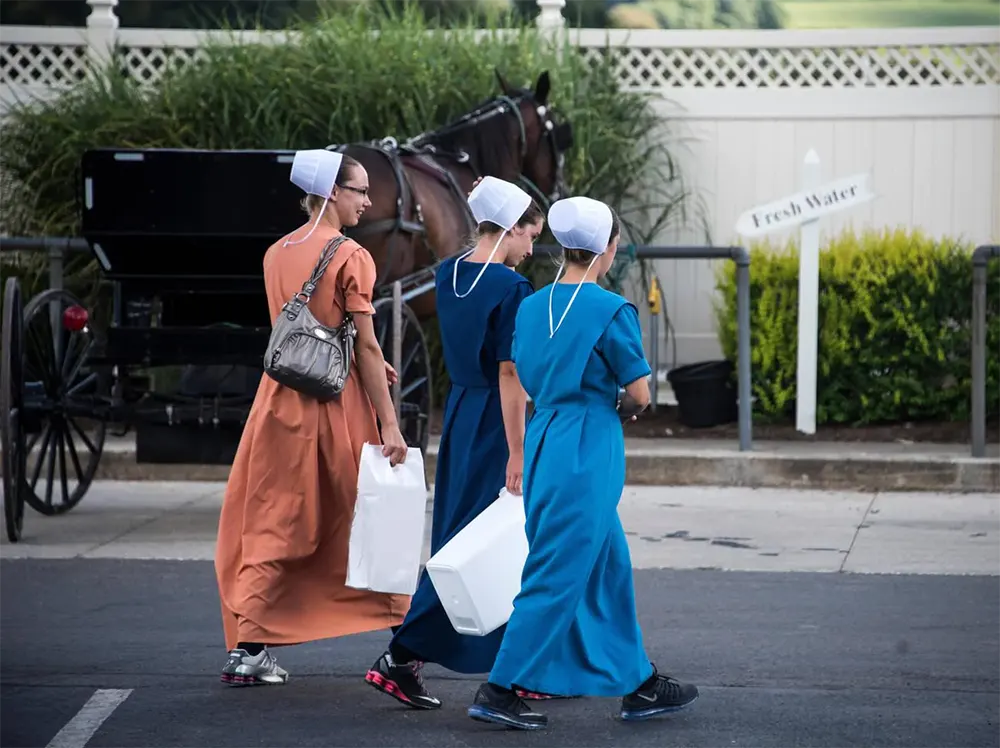
The Amish bonnet, a simple yet profound symbol of the Amish community’s identity, carries centuries of tradition, culture, and values. This head wear is not just a fashion statement but a representation of faith, modesty, and a way of life that’s unique from the rest.
Whether you’re a fashion enthusiast, a cultural explorer, or someone intrigued by simpler life, a deeper understanding of the Amish bonnets offers a unique perspective on a community that prioritizes modesty, tradition, and a sense of belonging.
Key Takeaways:
- The Amish bonnet is not just attire but a deep-seated symbol of faith, modesty, and identity.
- White and black bonnets distinctively indicate marital status within the community—white for married women and black for unmarried.
- Amish bonnets vary to reflect seasons, occasions, and orders, blending practicality with cultural significance.
- Bonnets exemplify the community’s emphasis on simplicity, modesty, and a deliberate choice against modernity.
In this article, we’ll look closer into this cultural choice, understanding its implications and the messages it conveys within the Amish community.
Understanding the Amish Bonnets: A Cultural Icon
An Amish bonnet might appear to be a mere accessory to the untrained eye. Nonetheless, it is a potent symbol of community and religious devotion.
The historical roots of these head coverings stretch deep into the Amish tradition, serving both a practical purpose and symbolizing a woman’s role within the community.
The distinction between white and black bonnets is a subtle component of their culture, representing marital status and signaling a deeper sense of identification and affiliation.
Why Do The Amish Wear Bonnets?
The Amish wear bonnets as part of their deep-rooted commitment to modesty, humility and their interpretation of Christian teachings, explicitly drawing from Corinthians 11.
This scripture suggests that men should have their heads uncovered for prayer, whereas women should cover their heads at all times during worship and in their daily lives.
The bonnet is a physical covering and a symbol of obedience to their faith. It signifies the wearer’s commitment to the community’s guidelines and dedication to a life of simplicity and non-conformity to mainstream societal trends.
Additionally, the bonnet helps to maintain a sense of unity and identity within the Amish community. Its specific styles and colors can indicate the wearer’s age, marital status, and, sometimes, district affiliations within the broader Amish society.
The Different Types of Amish Bonnets
In the Amish community, unmarried girls wear black bonnets, while married women wear white, making it easy to see their relationship status.
Now, in North America, where the largest settlement of Amish is located, numerous head coverings are worn. To give you a closer look, we will go through each of them and learn the traditional practices behind these prayer coverings.
Old Order Amish Kapp
This head covering is the most common among Amish people and the Old Order Amish. The majority of the Amish communities in America use it. There is no doubt of this since the old-order Amish make up a significant fraction of the Amish population.
New Order Amish Kapp
This slightly different kapp is usually worn by the new-order Amish. It differs from the old-order Kapp in terms of appearance, shape, and material.
Dan Amish or Andy Weaver Amish
The Dan Amish prayer covering, also known as the Andy Weaver Amish, originated in 1954. This type appears a lot simpler than the typical head covering. It is firm and fits the head snugly.
Swartzentruber Amish
The Swartzentruber Amish are regarded as the plainest people in Holmes County, so it is not surprising that their head covering is one of the plainest types.
Worn by some in the New Amish settlements
This head covering does not have a particular name but is said to be worn by a small population of Amish women in the new settlements. Its pleats are less defined than the standard head coverings.
Geauga County Amish
The Kapp used in Geauga County originated in 1886 and was used by the Amish people in the settlement. Its flat side is wider compared to the pleated part of the Kapp.
Lancaster Covering
Pennsylvania Amish widely use this unique-looking prayer covering. It looks different from the rest because of its heart-shaped appearance and absence of pleats.
Nebraska Amish Covering
The Nebraska Amish covering has the most undefined appearance among the head coverings. Many Amish wear them in Big Valley, Pennsylvania.
Nebraska Amish Woman’s Hat
The hat is not specifically a bonnet but still a head covering. The Nebraska Amish woman’s hat is made of straw and used as protection from the sun’s scorching heat.
Amish Girls Head Covering in Milverton, Ontario
This black Amish bonnet is commonly worn by Amish Girls in Milverton, Ontario. The material is thicker than the white ones used by older women in the community. The black bonnet has two different designs. The larger one is utilized by Amish girls when traveling in a carriage.
Veiling or Veil
Veils are worn to protect Amish bonnets when doing chores or running errands. Like the bonnets, the veils come in white and black colors.
Black Amish Covering
The head covering is worn by unmarried women in Amish communities. They are generally made of silk. The appearance resembles the head coverings worn by old and new orders of Amish but in black.
Covering worn for work by some Amish girls
The last type of covering is the white Amish bonnet frequently used by girls in the community. They use this Kapp while working outdoors or indoors. The strings of the head coverings are not tied or cut; they are placed at the back.
The Amish White Bonnet vs Black Bonnet
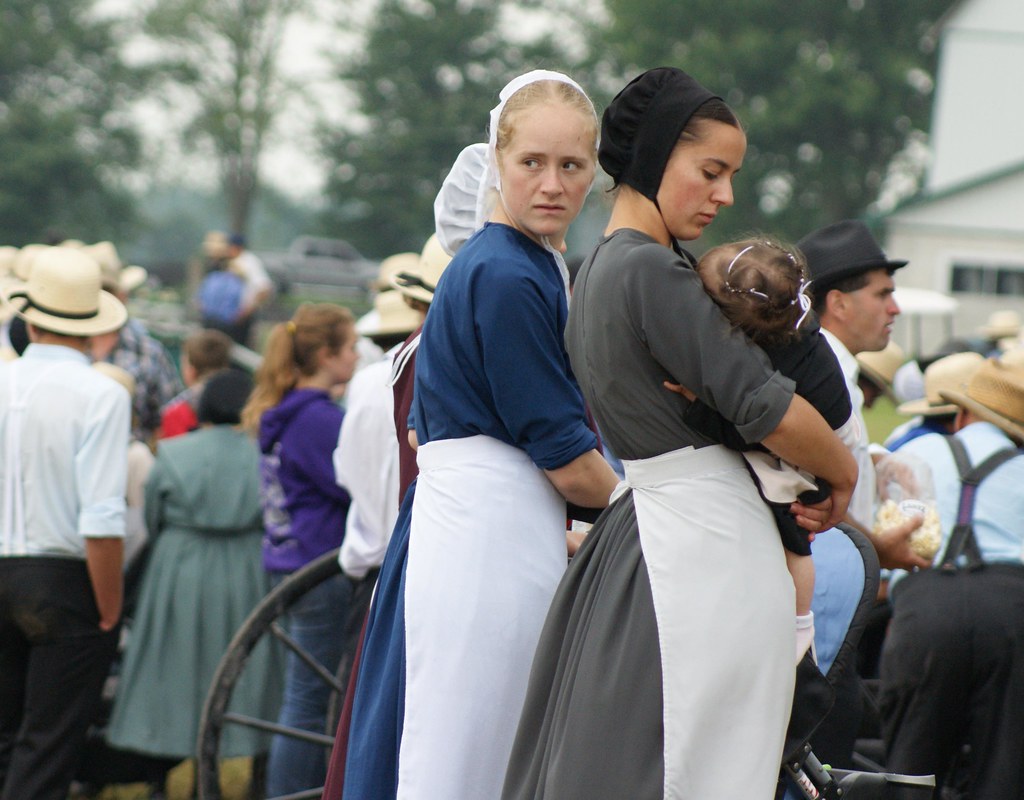
The way Amish women wear either white or black bonnets shows how traditional clothes can reflect deep cultural rules and personal beliefs. These bonnets are more than just part of a dress code; they’re visible signs of who they are, their beliefs, and where they fit in society.
Despite their simple appearance, Amish bonnets are powerful symbols of the community’s traditions, reminding everyone of shared values and each person’s place in the group.
The Amish bonnet represents more than just a piece of clothing; it symbolizes the community’s deeper commitment to a lifestyle that values spirituality over material wealth, unity over individualism, and modesty over showiness.
This dressing style mirrors the Amish’s broader perspective on life, emphasizing simplicity, humility, and a solid dedication to their faith. The Amish express their adherence to these principles through their attire, showcasing a way of life that prioritizes collective values and spiritual integrity.
White Bonnets: Symbolism and Use
The white bonnet isn’t just headwear; it’s a beacon of marital status, purity, and commitment within the Amish community. Worn by married women, the white bonnet goes beyond its functional purpose of covering the head and hair, standing as a testament to the wearer’s devotion to her faith and her partner.
The white bonnet’s plainness mirrors the broader Amish belief in living humbly and modestly. Its lack of decoration is deliberate, avoiding any show of vanity to highlight the importance of spiritual values over material ones.
Black Bonnets: Signifying Unmarried Women
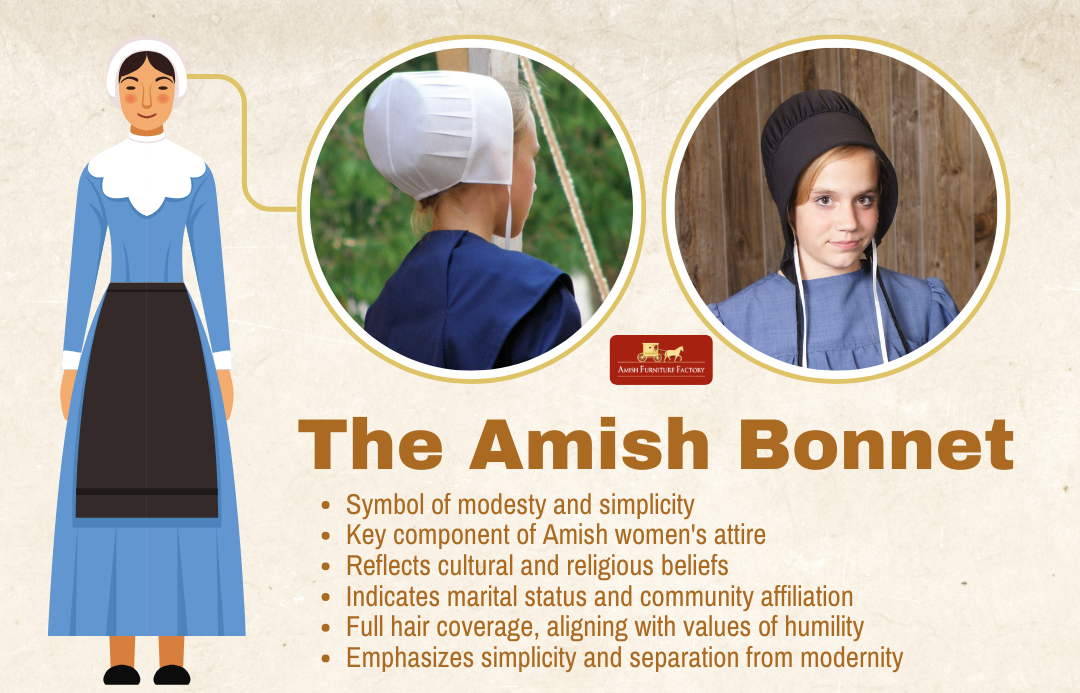
Unmarried women traditionally wear the black bonnet. The color quickly tells people if someone is married or not.
Often associated with simplicity and humility, black aligns with the Amish principles of modesty and plainness. Much like its white counterpart, the bonnet is imbued with meaning, serving as a daily reminder of the wearer’s faith, values, and expectations of their community.
Below is an overview of the key differences between the Amish white and black bonnets:
How Do the Amish Wear Bonnets?
The way Amish men and women wear their hats and bonnets varies. Every Amish community makes use of different materials for their bonnets.
A larger black covering in church typically accompanies the Kapp. Married Amish women are to wear these two at all times. However, this practice is not strictly observed because of the difficulty and nuisance that the summer heat brings.
How the bonnets are worn and tied depends on the occasion and community. The bonnet strings are tied tighter in low Amish churches than in other churches. In highly progressive communities, bonnets are still intact.
Men and Their Straw Hats
Men, on the other hand, wear their straw hats or bowler caps instead of Amish bonnets. These hats are called scribblers.
They are usually made with straw, wool, or fur. They may change depending on the season, but men commonly use those made with straws. They do not need to wear it at all times except at church.
Children and Their Head Coverings
Children, especially girls, wear hats, head coverings, or veils at a young age. They are also dressed like adult women as early as four.
Amish people teach their culture and values to young ones as they grow up in the community. They continue to foster their culture and traditions by passing them to the younger generations as early as possible.
Why Do the Amish Wear Plain Clothing?
The Amish choice to wear plain clothing is deeply interwoven with their religious beliefs, values, and way of life. Choosing to dress simply and modestly goes beyond just picking out clothes; it’s about living a life that avoids showing off, values humility, and strengthens community bonds.
A Reflection of Faith and Humility
The Amish interpret biblical teachings to mean that one should not dress in a way that attracts attention to oneself or promotes vanity. By wearing plain clothing, they aim to live a life that focuses on inner virtues rather than outward appearances.
A Marker of Identity and Community
Amish clothing is a visual identity marker, immediately distinguishing community members from the outside world. This distinctiveness reinforces a sense of belonging and unity among Amish people, reminding them of their shared values and commitment to a way of life separate from mainstream society.
Practicality and Durability
Their choice of plain clothing is also practical, as simpler garments are more durable and suited to the physical nature of their daily activities. The fabrics are typically sturdy, and the designs are functional, ensuring that clothing can withstand wear and tear while providing comfort and ease of movement.
Resistance to Modernity and Change
The Amish reluctance to adopt modern conveniences extends to their attire. By sticking to traditional clothing styles, they resist the influences of contemporary fashion trends and the fast-paced changes of the outside world. This resistance is part of a broader intention to maintain a simple, slow-paced way of life.
Teaching and Reinforcing Values
For the Amish, wearing plain clothing is also an educational practice, teaching children from a young age about the values of their community. Young Amish learn about modesty, humility, and prioritizing communal harmony over individual expression through attire.
This daily practice of wearing simple clothes reinforces the community’s values and beliefs, ensuring they are passed down through generations.
Conclusion: The Enduring Legacy of Amish Bonnets
In their simplicity, the Amish bonnets reveal much about the Amish way of life, emphasizing modesty, tradition, and a sense of belonging.
Married women wear white bonnets as a symbol of purity and commitment, while black bonnets signify the unmarried status of younger women. These distinctions in bonnet color help communicate marital status and reflect deeper Amish values of simplicity and humility.
The bonnets are part of a broader Amish dress code that rejects modernity and focuses on practicality, durability, and resistance to change. They reinforce the community’s values of faith, modesty, and unity. Wearing these bonnets isn’t just about following tradition; it’s a daily reaffirmation of an Amish woman’s faith, role, and the communal values she lives by.
FAQs
What is Amish headwear called?
Amish women’s headwear is known as a “bonnet” or “Kapp,” while men wear “hats,” typically broad-brimmed for practicality and modesty.
What is the difference between Amish and Mennonite bonnets?
The main difference lies in the style and sometimes color. Amish bonnets are more uniform and conservative, often reflecting marital status, while Mennonite bonnets can vary more in style and color, indicating a broader diversity within Mennonite practices.
What are the Amish bonnet rules?
Amish bonnet rules emphasize wearing bonnets as a sign of modesty and religious devotion, with color indicating marital status (white for married women, black for single women). The bonnets are simple, without decoration, and are worn almost at all times in public, reflecting the community’s values of humility and unity.

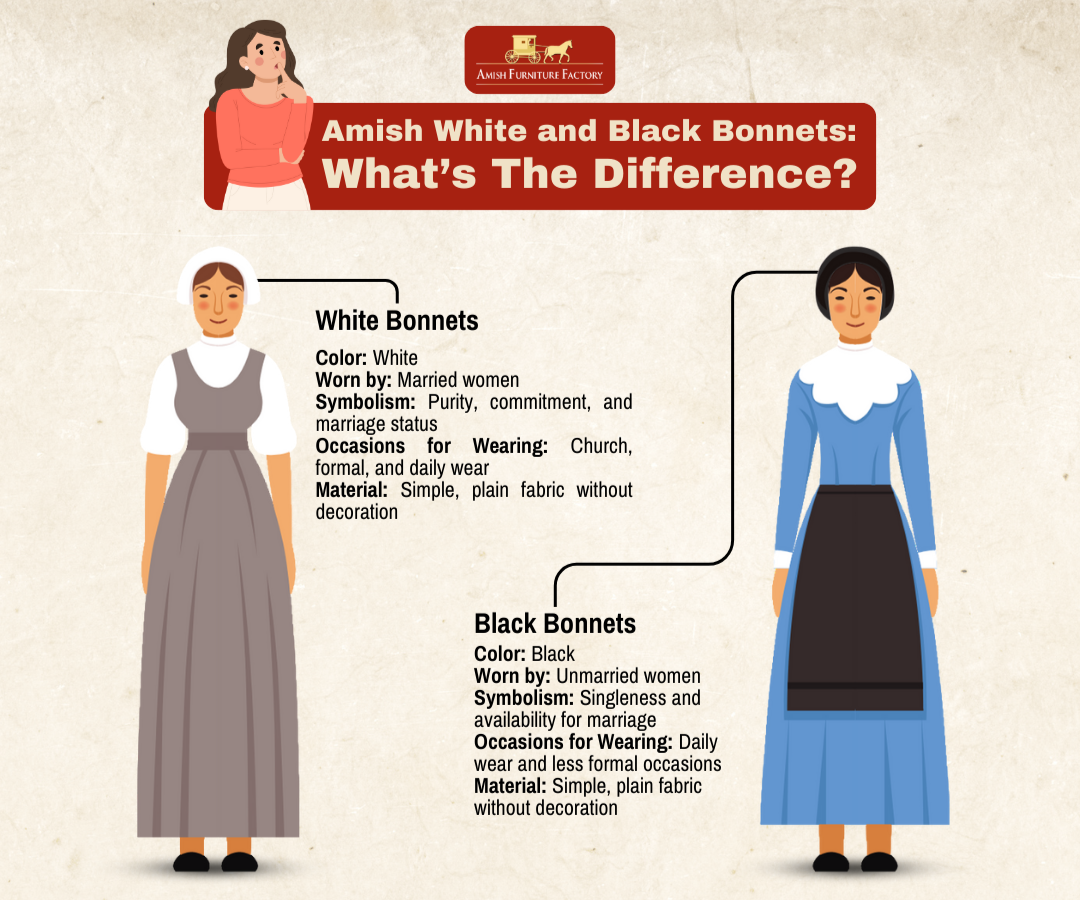

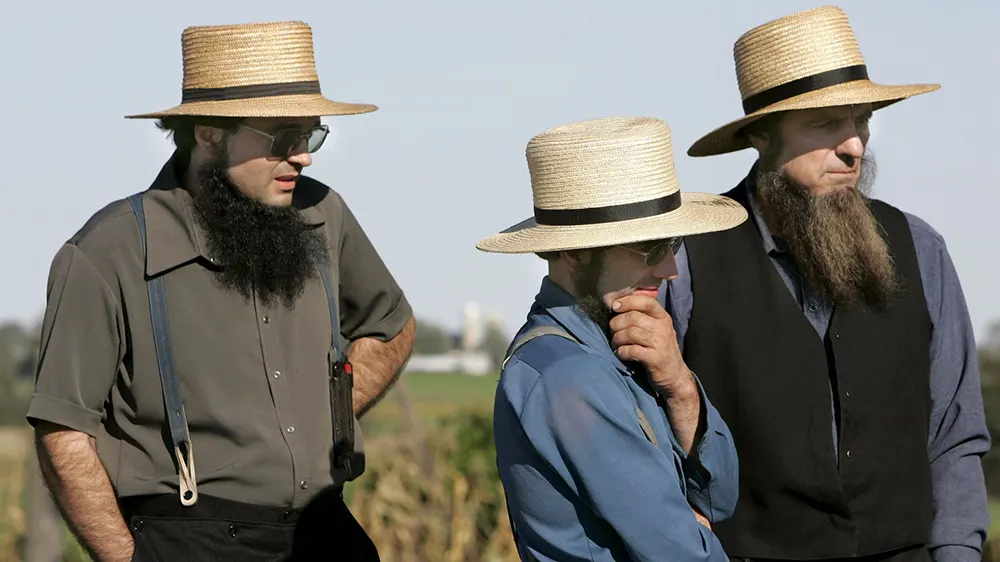

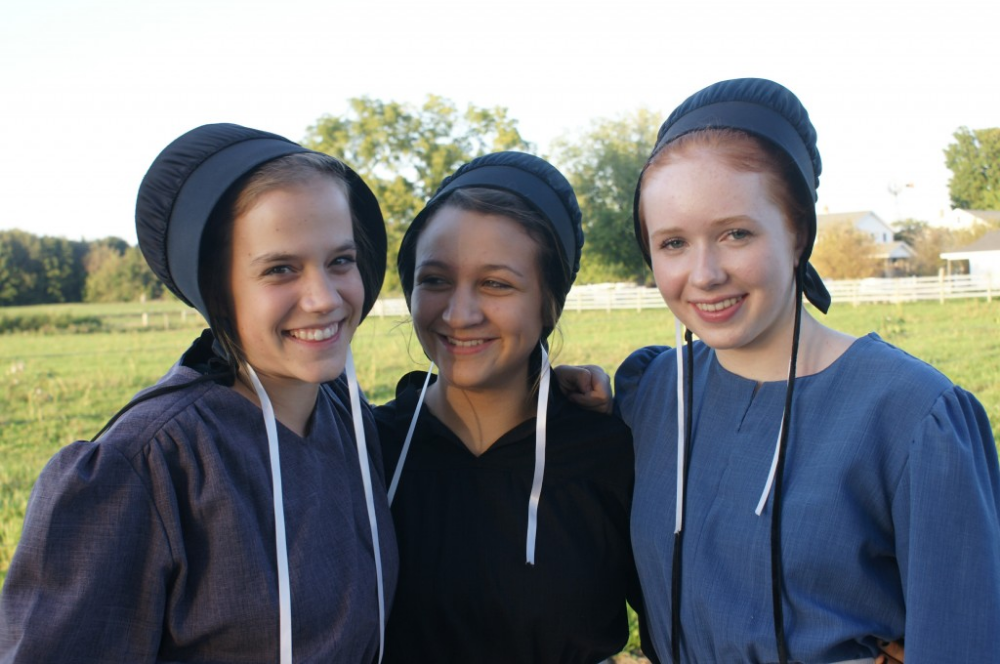
I grew up in PA and was always told that the white caps were prayer caps worn by adult women. But the black bonnets were worn over the white and were for covering the hair and prayer cap when going out.